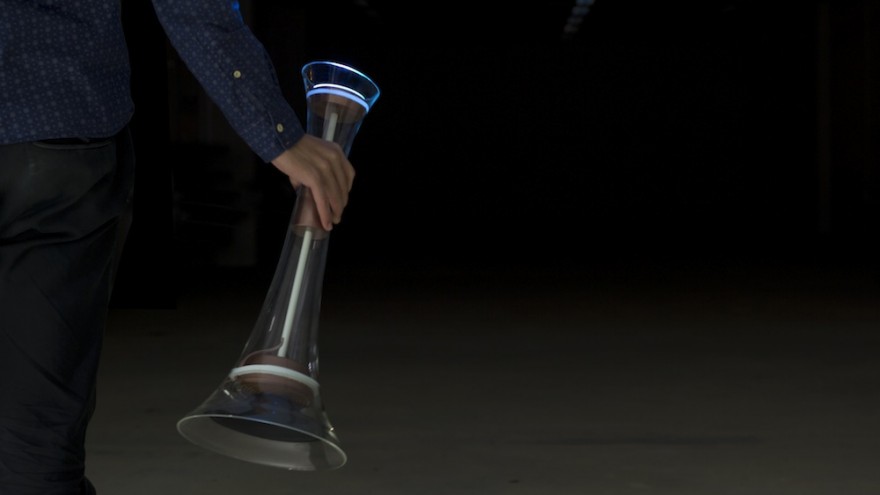For many music lovers, sliding a record out from its sleeve and touching the needle down is a ritual that forms part of the listening experience itself. Joris Petterson, a 2014 graduate of Design Academy Eindhoven, created the Mood of Music speaker system to remind us that music has for years had a tangible context that was a by-product of our means of sound reproduction.
There’s more to music than just sound, Petterson points out. Music is an experience; it’s like an atmosphere.
As digital files become the norm for music distribution, the act of listening has changed. After having tactile representations of music for years, the sounds we now play back exist only as data; they are disembodied, with no physical form. Petterson seeks to return the experience to our music listening through his device.
Shaped like a classic gramophone horn in clear perspex, Mood of Music has a built-in speaker but also emits light, colour and scents to complement the music being played.
Petterson’s research took into account changes in people’s listening patterns. He observed that people often listen to music less as a primary activity and more as a background to other tasks. This results in listeners, and digital content providers like Spotify, naming and categorising their playlists according to the atmosphere they would suit – from a relaxed dinner party to a high-intensity dance session.
Instead of putting on a song, we put on an atmosphere, Petterson notes.
"Till today we were only able to hear this mood" as opposed to involving our other sense, he says. He gives some examples: “A playlist called ‘Dark & Stormy’ will be accompanied by bluish colours and the salty smell of the sea. Scratchy live-performances from Harlem will be supported with, for example, the smell of whisky and cigars.”
The speaker is wirelessly controlled from your smartphone, laptop or tablet to respond to what you play. It then uses metadata that is associated with your music files to generate outputs. For instance it can select light colours based on the image file attached to a song or playlist, such as a picture of the artist or album cover. Individual scents can also be ordered online and inserted for your personal preference.
Another of his graduate works, the Home Barista, indulges one of his personal passions – good coffee. He questions the current way we drink coffee, especially as consumers are more aware than ever of quality beans and interesting brewing techniques. “At home we drink our coffee prepared with one and the same method. Why don’t we vary more with coffee, like we do with food?” he asks.
The modular Home Barista system allows for a wide variety of brews, from cappuccino to espresso, and ensures that you can personalise every cup.
Much of Petterson’s work focuses on lifestyle and the importance of how we experience our daily activities. Growing up in the countryside formed the backdrop to his introduction to design – he says he caught the design bug at age 11 when he witnessed his parents’ renovation of a formal farmhouse into a modern dwelling.
During his studies in Eindhoven, Petterson specialised in product design, research and concept development. He learned that research played a huge factor in shaping the quality of the design outcome. “It turned out that the more I implemented research in my design process, the better the design got. It gave structure and grip. I believe that research stimulates innovation and inspires. It helps to step away from and rethink the existing,” he says.













